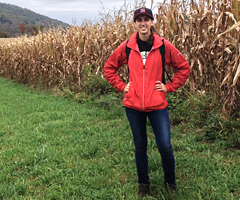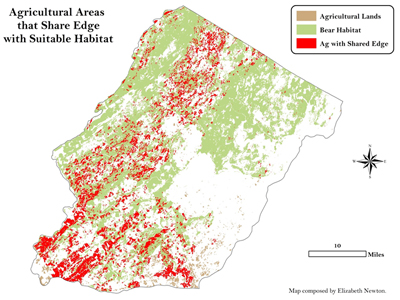Newton Presents Bear Research at Wildlife Society Meeting
 Elizabeth (Liz) Newton, a senior EENR major conducting research with Dr. Brooke Maslo, reported her research on black bear activity in northwestern New Jersey at the October 2014 meeting of the New Jersey chapter of The Wildlife Society.
Elizabeth (Liz) Newton, a senior EENR major conducting research with Dr. Brooke Maslo, reported her research on black bear activity in northwestern New Jersey at the October 2014 meeting of the New Jersey chapter of The Wildlife Society.
Newton’s research merges her knowledge from her own ecological background with data on the occurrence of black bears, collected by the New Jersey Department of Environmental Protection’s Division of Fish and Wildlife. With their data, they generated a maximum entropy “heat map” (right), which depicts predicted hot and cold spots for bear presence. Under Maslo’s guidance, Newton then manipulated the heat map to predict the overlap between suitable bear habitat and agricultural areas, finding that 11% of suitable bear habitat overlaps agricultural land.
 Of even greater significance is that 42.5% of agricultural field edges border potential bear habitat, suggesting that bears could cause considerable damage to crops. Newton says that such damage is “straightforward to identify—the females lie down in crops and roll, bringing the corn stalks down for herself and the cubs to eat, and the males usually sit in one spot and grab corn from the stalks.” However, she says, the extent of damage in New Jersey is difficult to quantify because surveying enough cornfields to make a robust assessment requires so much manpower. With the results from the bear presence heat map analysis, they hope to make a vulnerability map that delineates areas with higher probability of bear presence and therefore would be more likely to experience damage from bear predation. Farmers and the NJ Division of Fish and Wildlife would be informed and more prepared to take preventative measures.
Of even greater significance is that 42.5% of agricultural field edges border potential bear habitat, suggesting that bears could cause considerable damage to crops. Newton says that such damage is “straightforward to identify—the females lie down in crops and roll, bringing the corn stalks down for herself and the cubs to eat, and the males usually sit in one spot and grab corn from the stalks.” However, she says, the extent of damage in New Jersey is difficult to quantify because surveying enough cornfields to make a robust assessment requires so much manpower. With the results from the bear presence heat map analysis, they hope to make a vulnerability map that delineates areas with higher probability of bear presence and therefore would be more likely to experience damage from bear predation. Farmers and the NJ Division of Fish and Wildlife would be informed and more prepared to take preventative measures.
Can anything be done to dampen the threat of bears near agricultural or residential areas? “Farmers can currently apply for depredation permits [a type of permit that allows landowners to hunt problem bears to avoid further property damage], but a fair number of people do not support hunting. So it’s a question of how to manage [bears].” Newton and Maslo are currently investigating how to use their population projection models to guide wildlife management so that New Jersey residents, whether farmers, hikers, or the general public can avoid unwanted encounters with bears.
Molly MacLeod, December 2014


